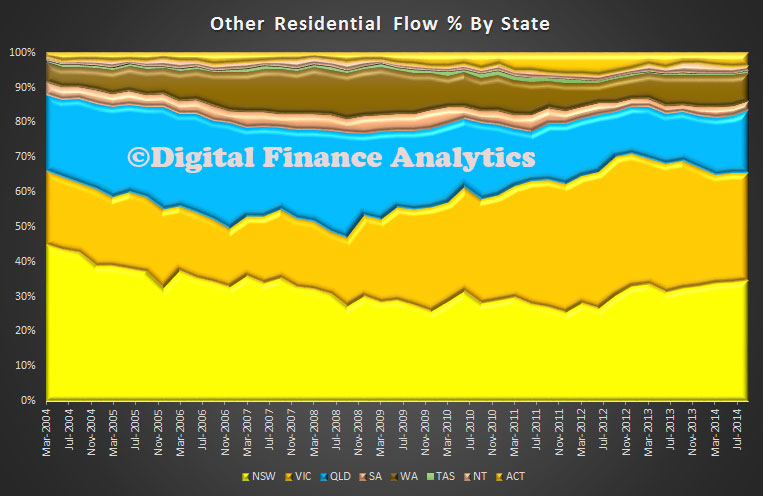We review the latest ABS construction work done data. The biggest fall in 18 years!
Tag: Construction
Construction Work Done Falls Again In September
The ABS released their preliminary data today. Tasmania apart, construction chain measures continue to fall. Trend estimate for residential building work done fell 3.0% this quarter and has fallen for four quarters.
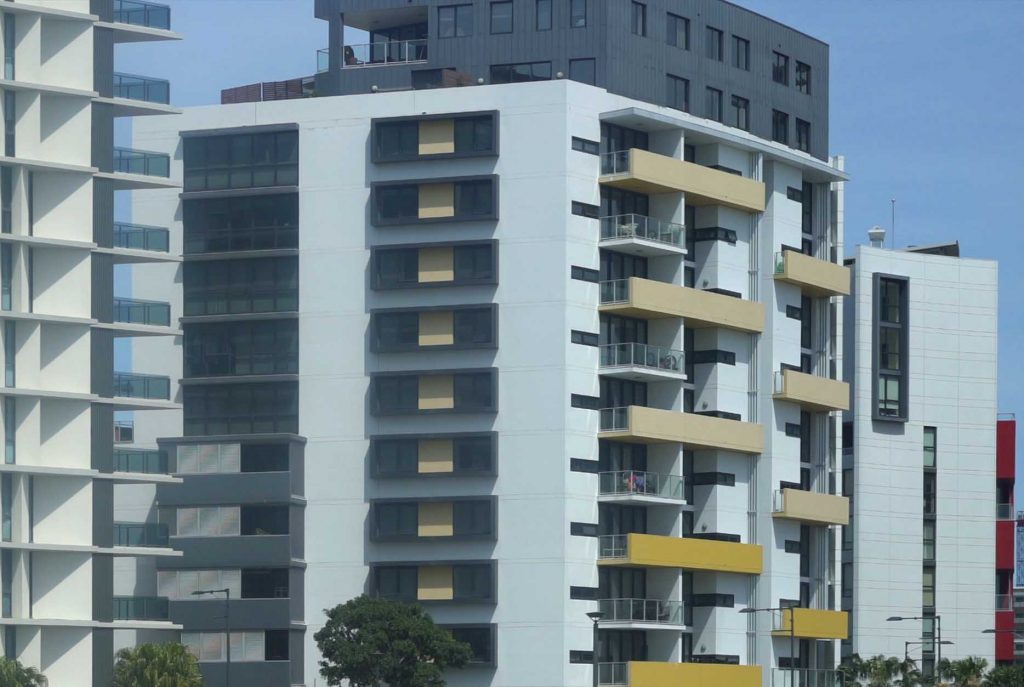
- The trend estimate for total construction work done fell 1.6% in the September quarter 2019.
- The seasonally adjusted estimate for total construction work done fell 0.4% to $50,849.7m in the September quarter.
- The trend estimate for total building work done fell 1.8% in the September quarter 2019.
- The trend estimate for non-residential building work done rose 0.2% and residential building work fell 3.0%.
- The seasonally adjusted estimate of total building work done fell 0.5% to $29,703.6m in the September quarter.
- The trend estimate for engineering work done fell 1.1% in the September quarter.
- The seasonally adjusted estimate for engineering work done fell 0.2% to $21,146.2m in the September quarter.
Trend percentage change: Total construction
The trend estimate for total construction work done fell 1.6% this quarter and has fallen for five quarters.
Trend percentage change: Engineering
The trend estimate for engineering construction work done fell 1.1% this quarter and has fallen for six quarters.
Trend percentage change: Building
The trend estimate for total building work done fell 1.8% this quarter and has fallen for four quarters.
Trend percentage change: Residential
The trend estimate for residential building work done fell 3.0% this quarter and has fallen for four quarters.
Trend percentage change: Non-residential
The trend estimate for non-residential building work done rose 0.2% this quarter and has risen for five quarters.
Chain volume measures – Trend estimates
New South Wales
Victoria
Construction work done in New South Wales has fallen for four quarters.
Construction work done in Victoria has fallen for four quarters.
Queensland
Western Australia
Construction work done in Queensland has fallen for six quarters.
Construction work done in Western Australia has fallen for eight quarters.
South Australia
Northern Territory
Construction work done in South Australia has fallen for five quarters.
Construction work done in the Northern Territory has fallen for eight quarters.
Tasmania
Australia Capital Territory
Construction work done in Tasmania has risen for seven quarters.
Construction work done in the Australian Capital Territory has fallen for four quarters.
Construction Work Falls In March Quarter
The ABS preliminary trend data shows a fall overall of 6.8% compared with a year ago to $46.2 billion. Within that residential construction fell 1%, non-residential construction fell 3.5% and engineering fell 12.4%. The trend for total building work was down 1.1% in the March quarter.
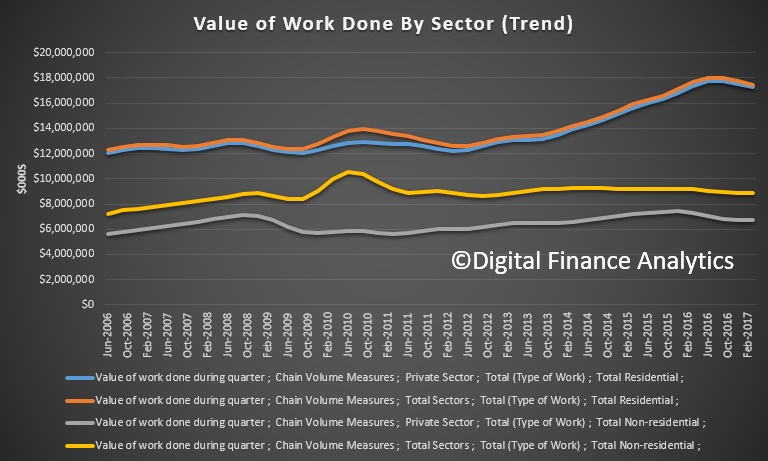 In fact only the public sector non-residential construction held momentum. In other words, it is government spending which is holding the number up, whilst private sector investment is falling.
In fact only the public sector non-residential construction held momentum. In other words, it is government spending which is holding the number up, whilst private sector investment is falling.
Within the residential data new houses and other residential both fell.
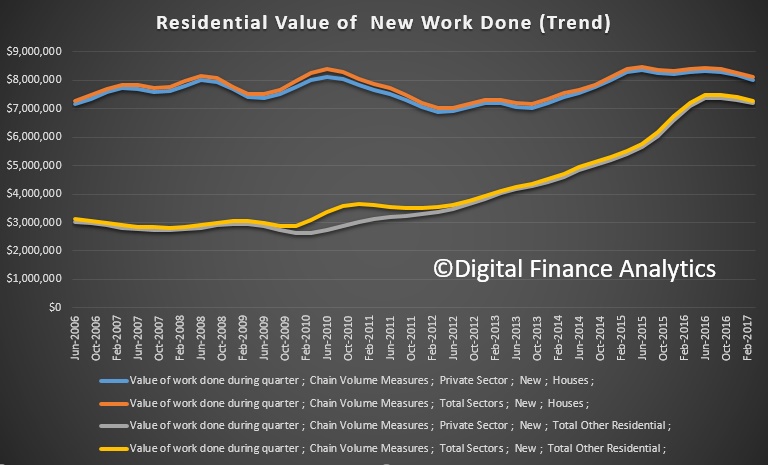 Once again the lack of business investment is taking its toll. With housing coming off, growth looks more uncertain, and only Government spending on infrastructure can it seems can save the day (but at what cost?)
Once again the lack of business investment is taking its toll. With housing coming off, growth looks more uncertain, and only Government spending on infrastructure can it seems can save the day (but at what cost?)
Construction Momentum Continues
The data from the ABS shows that the trend estimate of the value of total building work done rose 1.1% in the March 2016 quarter with new residential building work up 2.8%, whilst the value of non-residential building work done fell 1.2%. As a result, 66% of all building activity was for residential purposes, a record. Construction momentum continues therefore, despite falls in building approvals over the same period.
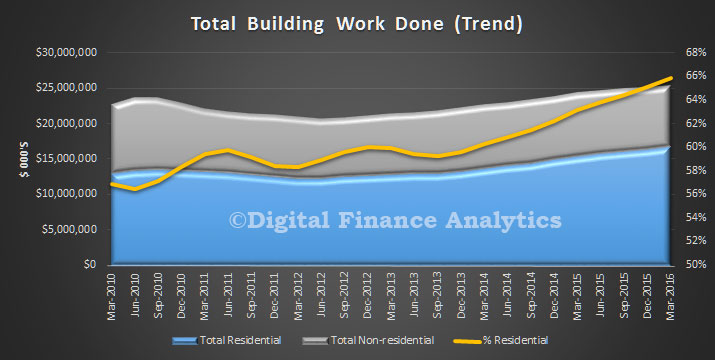 The trend estimate for the total number of dwelling units commenced rose 1.8% in the March 2016 quarter following a rise of 1.2% in the December quarter. Looking at the mix of residential activity, the value of work done on new houses fell 0.7% while new other residential building (units, apartments etc.) rose 7.1%. As a result, 47% of value in March 2016 was for dwellings other than housing, a record. The trend estimate for new private sector house commencements fell 1.4% in the March quarter following a fall of 1.5% in the December quarter. The trend estimate for new private sector other residential building commencements rose 5.5% in the March quarter following a rise of 4.9% in the December quarter.
The trend estimate for the total number of dwelling units commenced rose 1.8% in the March 2016 quarter following a rise of 1.2% in the December quarter. Looking at the mix of residential activity, the value of work done on new houses fell 0.7% while new other residential building (units, apartments etc.) rose 7.1%. As a result, 47% of value in March 2016 was for dwellings other than housing, a record. The trend estimate for new private sector house commencements fell 1.4% in the March quarter following a fall of 1.5% in the December quarter. The trend estimate for new private sector other residential building commencements rose 5.5% in the March quarter following a rise of 4.9% in the December quarter.
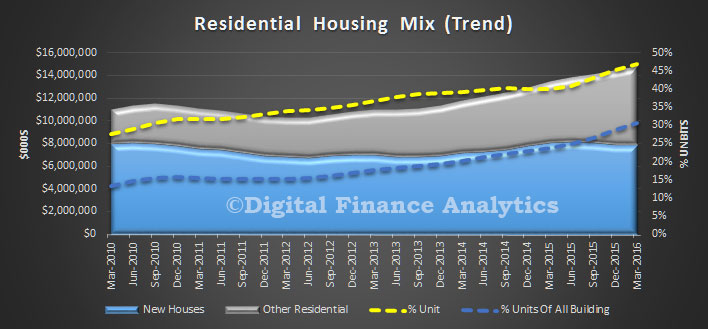 Overall, 30% of all construction activity (including residential and non-residential) was for units and apartments, with more than 30,000 units in the quarter. This is another record and highlights again the risks in the system.
Overall, 30% of all construction activity (including residential and non-residential) was for units and apartments, with more than 30,000 units in the quarter. This is another record and highlights again the risks in the system.
Finally, it is worth noting where the momentum lays, because there are significant state variations. Looking at the year March 2016, new dwelling commencements rose in ACT (44.1%), NSW (24.1%), QLD (13.1%), VIC (11.6%) and TAS (6.6%). On the other hand they fell in NT (-24.7%), WA (-19.0%) and SA (-3.1%).
Construction Momentum Continues, In Places
The preliminary ABS data on construction work done, released today to December shows that the trend estimate for total construction work done fell 1.6% in the December quarter 2015 whilst the the seasonally adjusted estimate for total construction work done fell 3.6% to $48,413.4m in the December quarter.
However, the trend estimate for total building work done rose 1.0% in the December quarter, with non-residential building work done rising 0.3% and residential building work up 1.4%. The seasonally adjusted estimate of total building work done rose 2.7% to $24,990.2m in the December quarter.
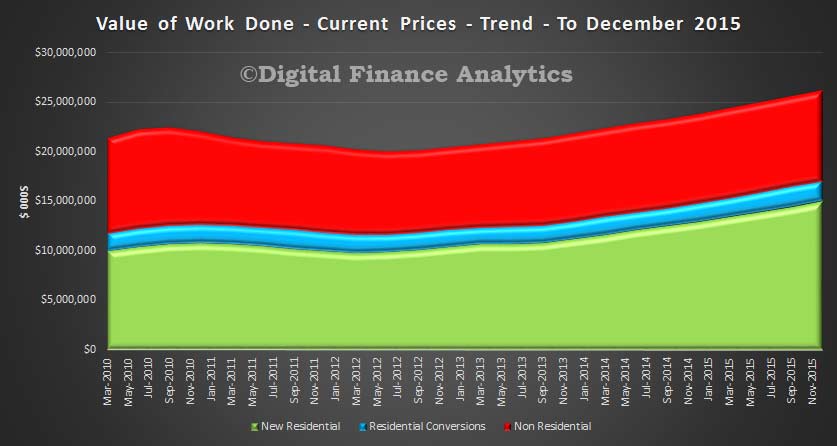 In contrast, the trend estimate for engineering work done fell 3.9% in the December quarter and the seasonally adjusted estimate for engineering work done fell 9.5% to $23,423.3m in the December quarter. So growth continues to rely on the housing sector.
In contrast, the trend estimate for engineering work done fell 3.9% in the December quarter and the seasonally adjusted estimate for engineering work done fell 9.5% to $23,423.3m in the December quarter. So growth continues to rely on the housing sector.
The state by state data on residential construction (original data, so no smoothing) shows some significant movements.
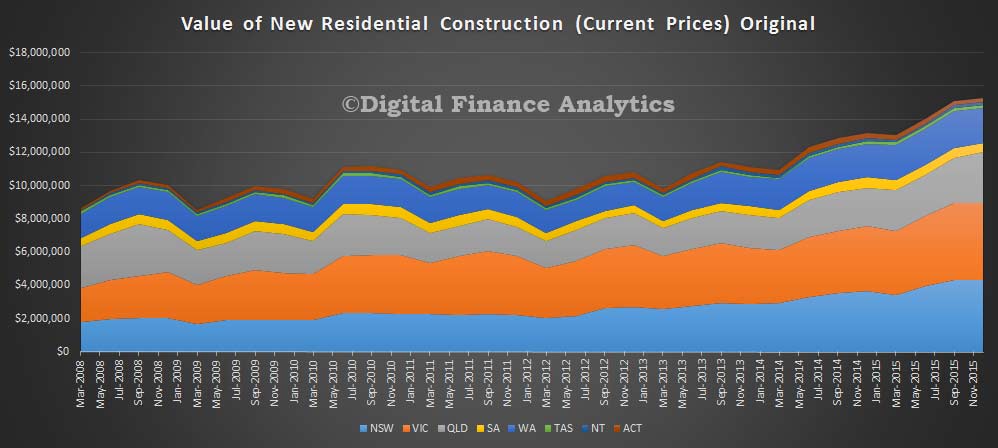 In NSW, total new residential construction rose 0.21%, whilst VIC rose 0.28%. Both states are suggesting slowing momentum. This is in contrast to QLD which has shown growth of more than 10% the past two quarters. SA dropped 6.5% (reversed the 4.9% movement in the prior quarter) whilst WA fell 5%, the first fall since 2013.
In NSW, total new residential construction rose 0.21%, whilst VIC rose 0.28%. Both states are suggesting slowing momentum. This is in contrast to QLD which has shown growth of more than 10% the past two quarters. SA dropped 6.5% (reversed the 4.9% movement in the prior quarter) whilst WA fell 5%, the first fall since 2013.
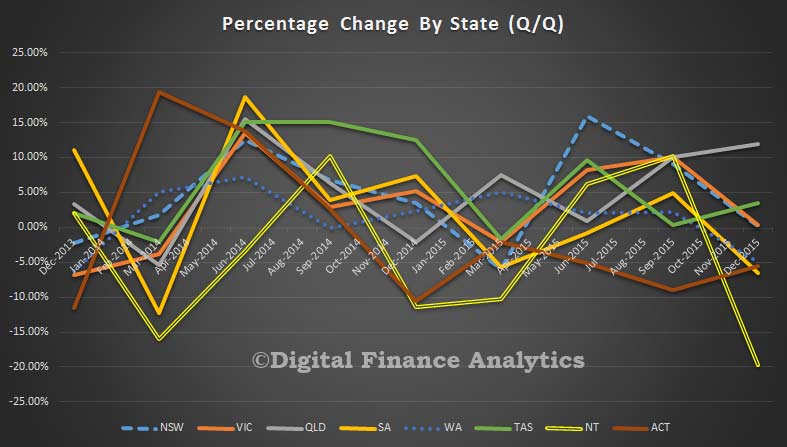 Data from TAS, NT and ACT are more volatile so probably less significant, with NT falling 19.7% (after a 10% rise last time), ACT 5.6% (the fifth consecutive quarterly fall) and TAS rising 3.5%.
Data from TAS, NT and ACT are more volatile so probably less significant, with NT falling 19.7% (after a 10% rise last time), ACT 5.6% (the fifth consecutive quarterly fall) and TAS rising 3.5%.
New Home Sales Falter in May – HIA
The HIA New Home Sales Report, a survey of Australia’s largest volume builders, recorded the first decline for 2015 in May. The four month winning streak came to a modest end in May 2015 with total seasonally adjusted new home sales falling by 2.3 per cent. The decline was driven by a 5.1 per cent dip in detached house sales, reflecting weaker monthly demand in four out of the five states surveyed. DFA observes that the rotation from houses to units continues to build momentum, in answer to the demand for investment property, where returns to builders are also higher.
The mature stage of the new home building cycle primarily reflects further momentum in the ‘multi-unit’ sector, together with persistence of healthy conditions in New South Wales and Victoria. New sales of multi-units increased by 7.6 per cent during the month to yet a new record level, with sales volumes up by 26.7 per cent over the three months to May. Meanwhile strength in detached houses sales is evident in NSW and Victoria, with growth in the May 2015 ‘quarter’ of 5.2 per cent and 6.2 per cent, respectively.
 In the month of May 2015 detached house sales increased by 3.3 per cent in Queensland, but fell by 2.3 per cent in NSW, 9.9 per cent in Victoria, 5.2 per cent in South Australia, and 8.1 per cent in Western Australia. In the May 2015 quarter, detached house sales increased in NSW (+5.2 per cent) and Victoria (+6.2 per cent). Sales fell over the three month period in SA (-8.1 per cent), Queensland (-7.5 per cent), and WA (-1.3 per cent).
In the month of May 2015 detached house sales increased by 3.3 per cent in Queensland, but fell by 2.3 per cent in NSW, 9.9 per cent in Victoria, 5.2 per cent in South Australia, and 8.1 per cent in Western Australia. In the May 2015 quarter, detached house sales increased in NSW (+5.2 per cent) and Victoria (+6.2 per cent). Sales fell over the three month period in SA (-8.1 per cent), Queensland (-7.5 per cent), and WA (-1.3 per cent).
Re-balancing Unbalanced
Data from the ABS yesterday and today together sum up the problem with the Australian economy. Yesterday we got the latest construction data showing that mining was dropping, and construction, especially residential construction, was up, but not enough to compensate, so the overall trend is a fall in activity. The trend estimate for total construction work done fell 1.8% in the March quarter 2015. The trend estimate for non-residential building work done rose 0.2%, while residential building work rose 3.1%. The trend estimate for engineering work done fell 4.7% in the March quarter.
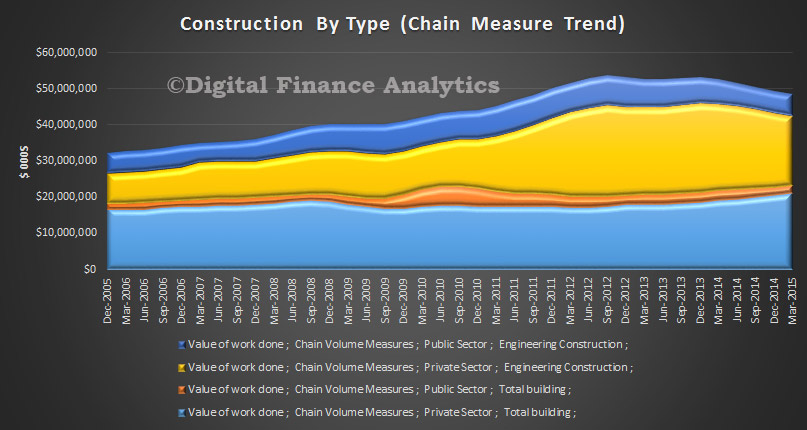 Today we got data on private sector capex. The trend volume estimate for total new capital expenditure fell 2.3% in the March quarter 2015, the trend volume estimate for buildings and structures fell 3.7% in the March quarter 2015 and the trend volume estimate for equipment, plant and machinery rose 0.7% in the March quarter 2015. Forward looking capital expenditure (a dodgy data set by definition) shows the same trend, mining falling away quicker then other part of the economy, including construction and manufacturing not filling the gap, so net trend is down.
Today we got data on private sector capex. The trend volume estimate for total new capital expenditure fell 2.3% in the March quarter 2015, the trend volume estimate for buildings and structures fell 3.7% in the March quarter 2015 and the trend volume estimate for equipment, plant and machinery rose 0.7% in the March quarter 2015. Forward looking capital expenditure (a dodgy data set by definition) shows the same trend, mining falling away quicker then other part of the economy, including construction and manufacturing not filling the gap, so net trend is down.
 The painful process of re balancing away from mining is unbalanced, and we do not think the gap will be closed by a combination of residential construction, and household spending. Further rate cuts won’t do much more to assist either. It is time for a concerted look at how to drive business harder, to make productive investments in future growth. This should be a time to drive public sector construction programmes harder. Otherwise, GDP will be weaker into 2017 than the budget base case suggests.
The painful process of re balancing away from mining is unbalanced, and we do not think the gap will be closed by a combination of residential construction, and household spending. Further rate cuts won’t do much more to assist either. It is time for a concerted look at how to drive business harder, to make productive investments in future growth. This should be a time to drive public sector construction programmes harder. Otherwise, GDP will be weaker into 2017 than the budget base case suggests.
Construction Falls In December
Data released today shows that the construction sector fell again in December.
The national construction industry continued to exhibit substantial weakness in December 2012. The overall rate of contraction eased for a third consecutive month in response to slower declines in activity and new orders. The seasonally adjusted Australian Industry Group/ Housing Industry Association Australian Performance of Construction Index (Australian PCI®) increased by 1.8 points in December to 38.8. The index has now remained below the critical 50 points level (that separates expansion from contraction) for 31 consecutive months.
By sector, commercial construction activity contracted at its slowest pace in just over two years, while the rate of decline in engineering construction again eased during the month. In contrast, house building activity declined at its steepest rate in three months amid weaker new orders. Apartment building activity also moved further into negative territory.
Businesses reporting declines in activity mainly attributed this to tight credit conditions, strong competition for existing work and uncertainty about the economic outlook. A number of reports from house builders indicated that the weakness in demand was marked by a reduction in home buyer enquiries and a lack of commitment from potential purchasers.
Apartment building turned down sharply to the lowest level in the past 16 months.
The Australian Industry Group Performance of Construction Index (Australian PCI®) in conjunction with the Housing Industry Association, is a national composite index based on the diffusion indexes for activity, orders/new business, deliveries and employment with varying weights.
Housing Construction Boom Wavers
The ABS published their preliminary construction work done data to September 2014. Overall the seasonally adjusted value of construction work done dropped 2.2 % to $51,146.4m in the September quarter and makes a 5.1% fall this year. Within the data, NT construction rose, helping to trim the damage, but the result was below market expectations. Within the data. new private residential construction fell by 2.0 per cent in the September quarter but is still 9.7 per cent higher for the year. But the big question is, has construction begun to falter, or will growth continue – building approvals data could suggests it has some way to run, but it looks a little more shaky now. The RBA is banking on construction powering on of course to reach escape velocity as the mining investment boom fades.
The seasonally adjusted estimate of total building work done fell 1.0% to $22,435.8m in the September quarter. The trend estimate for engineering work done fell 3.0% in the September quarter.The seasonally adjusted estimate for engineering work done fell 3.2% to $28,710.6m in the September quarter.
The trend estimate for total construction work done fell 1.2% in the September quarter 2014 but the trend estimate for total building work done rose 1.5% in the September quarter. The trend estimate for non-residential building work done rose 0.9%, while residential building work rose 1.8%. The trend estimates are derived by applying a 7-term Henderson moving average to the seasonally adjusted series. The 7-term Henderson average (like all Henderson averages) is symmetric but, as the end of a time series is approached, asymmetric forms of the average are applied. Unlike weights of the standard 7-term Henderson moving average, the weights employed have been tailored to suit the particular characteristics of individual series. So looking at trend data we see new houses more static than other residential development, (units).
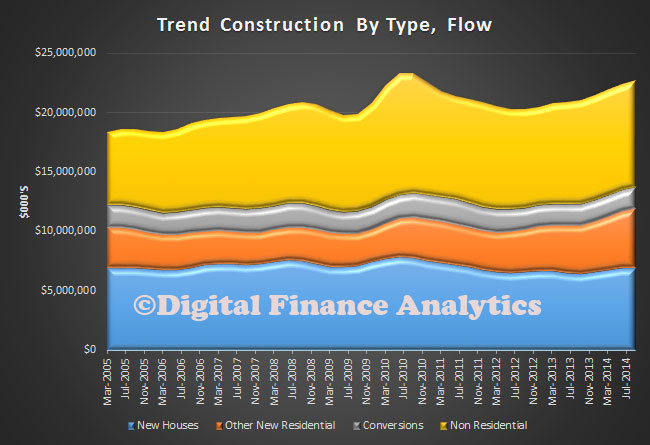 This is shown more starkly if we look at percentage distribution. Whilst conversions are relatively static, units and other non-house residential building is showing more momentum.
This is shown more starkly if we look at percentage distribution. Whilst conversions are relatively static, units and other non-house residential building is showing more momentum.
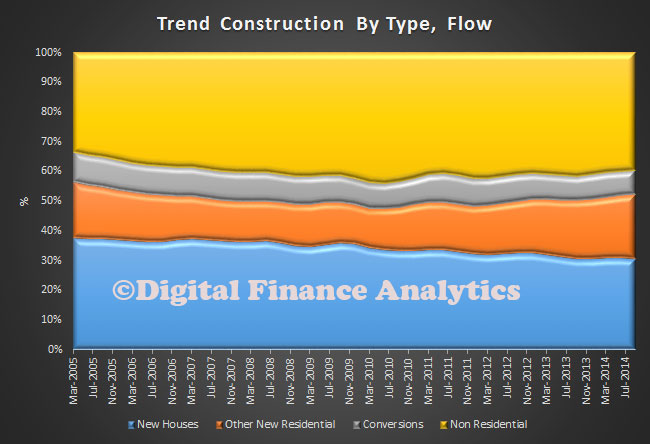 The original state data shows that more new houses were built in VIC than NSW, with WA and QLD close together.
The original state data shows that more new houses were built in VIC than NSW, with WA and QLD close together.
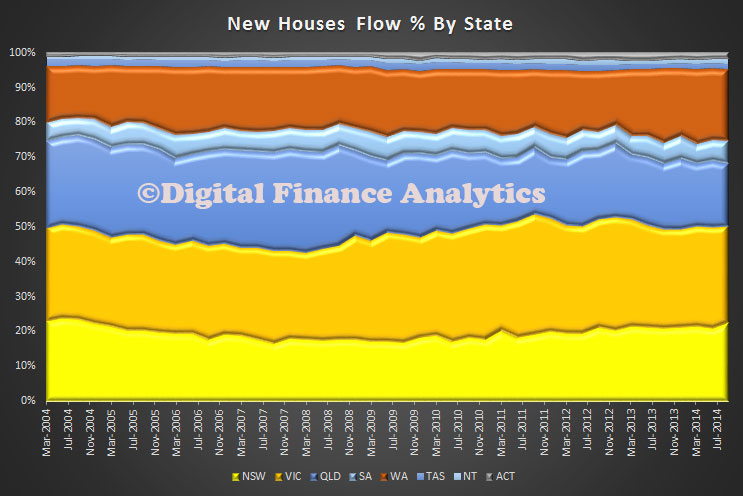 Turning to other types of residential building, we see that around 70% are locate across NSW and VIC. We see a spike in ACT units in 2011, but this seems to be slowing now. In WA more houses than units are being built.
Turning to other types of residential building, we see that around 70% are locate across NSW and VIC. We see a spike in ACT units in 2011, but this seems to be slowing now. In WA more houses than units are being built.

